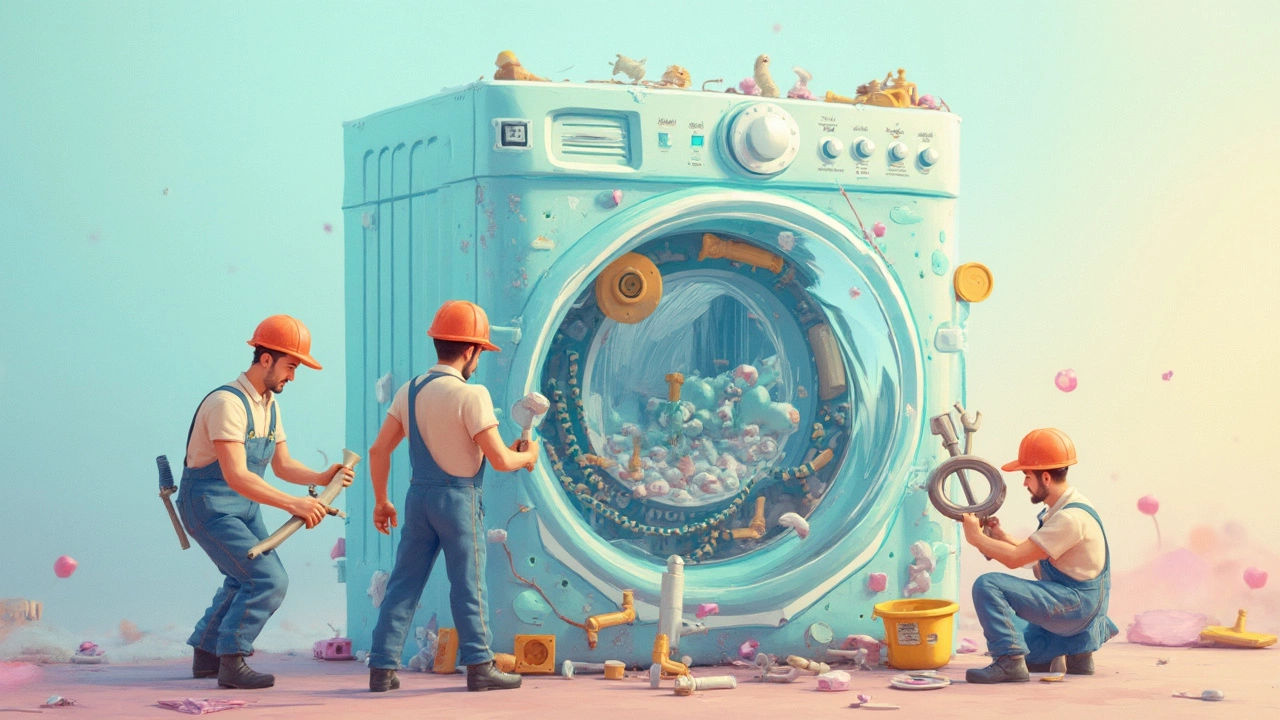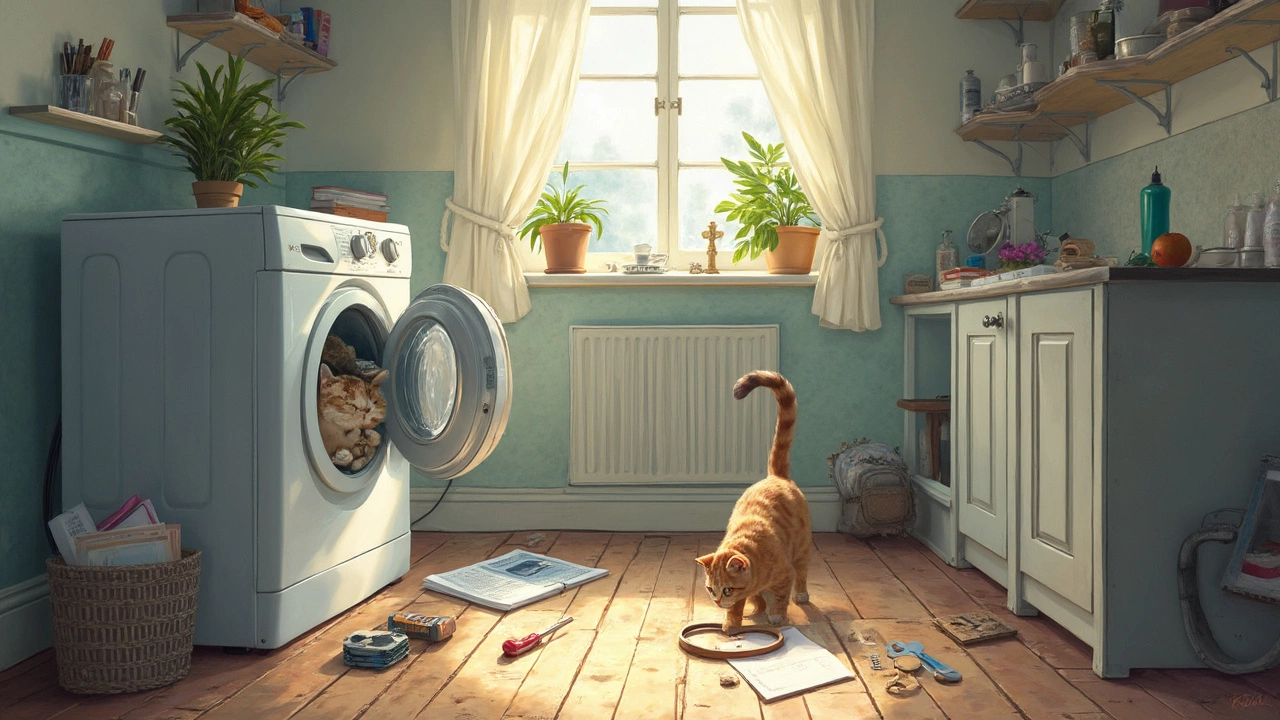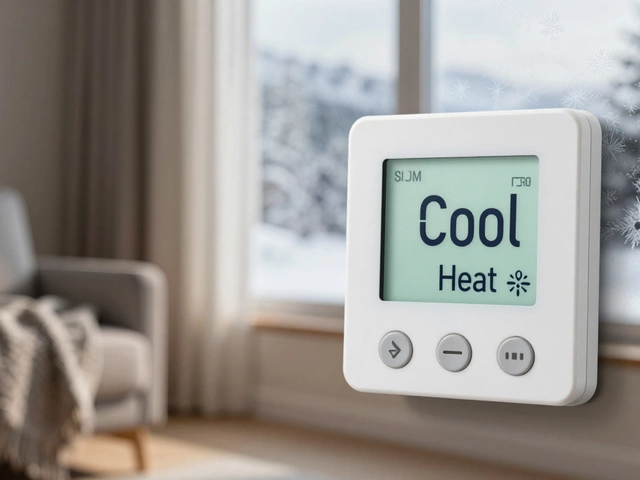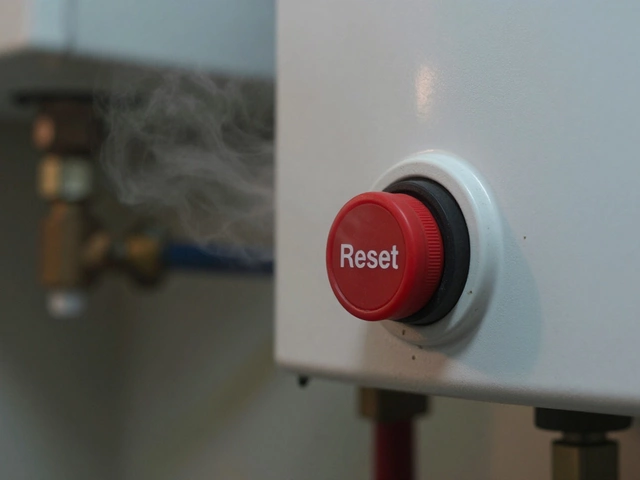Ever had your washing machine give up on you just when you needed it the most? Annoying, right? Most of the time, it's the same things that tend to go wrong, again and again.
Let's think about the usual suspects: how about that pesky door seal that loves to trap water and mold? It might not seem like a big deal until you open it up and breathe in a stink bomb worse than forgotten leftovers.
Or perhaps the water inlet valve decided it's had enough and calls it quits. Suddenly, the machine won't fill, and clothes stay damp and dirty. We all have this happen more than we'd like to admit.
But don't worry. There are some quick fixes you can try before calling in the pros, which we'll get into a bit later. Plus, a sprinkle of prevention goes a long way in keeping your trusty washing machine humming along.
The Usual Suspects
Let's get down to what usually goes on the fritz with your washing machine. First up, the belt. It’s not as trendy as a leather belt, but it’s essential for spinning your clothes. Over time, this thing wears out. You'll know it's time to change it when your washer sounds like a rock concert instead of a gentle hum.
Clogged hoses are another frequent culprit. You know that garden hose that always kinks when you're watering plants? Similar concept here, minus the garden. You should check for clogs if you notice water isn’t draining or filling. Sometimes shaking it out or running some water through can do the trick, but if it's too gnarly, a replacement might be in order.
Then there’s the matter of the pump—the heart of the machine. If it's busted, your washer isn't going to drain the water effectively. Listen for odd noises or look for leaks around this crucial part.
Door Issues
The door latch might seem innocent, but it's a sneaky one. If it doesn’t close correctly, your washer could start then stop. Double-check if fluff or dirt is blocking it.
Electronic Components
If your washing machine acts possessed—turns off unexpectedly or doesn't start—you could have an electronic issue on your hands. A simple reset by unplugging the machine for a minute can sometimes do wonders.
| Component | Issue |
|---|---|
| Belt | Worn out, slipping |
| Hoses | Clogged, kinks |
| Pump | Noisy, leaking |
| Door Latch | Obstructed, loose |
| Electronics | Erratic behavior |
Quick Fixes
So you're dealing with a washing machine hiccup and don't feel like shelling out for a repair person just yet? You're in luck. The good news is, many washing machine repair issues have simple fixes you can handle with a bit of know-how. Here are some of the most common things to check.
Unclogging Drains
If your machine isn’t emptying, a blocked drain might be the culprit. Pop open the access panel—usually down low on the front—and check the filter for stray socks or coins. It's surprising what treasures live there.
The Belt Check
A broken or loose belt can stop your drum from spinning like it should. If you hear the motor hum but see no action, it’s time for a look. Unplug the machine, peel back the access panel, and see if the belt is tight and intact. Replacing a belt is easier than setting up your new streaming service, trust me.
Water Inlet Valve Trouble
When your machine's not filling, the water inlet valve could be to blame. Turn off the water supply and detach the hoses to inspect the screens for gunk. A quick cleanout is often all it takes to get back on track.
Reset Cycle
Sometimes a simple reset does the trick. Unplug the machine, let it breathe for a minute, and plug it back in. Yep, it's the old "turn it off and on again" move. Magic, right?
If these common issues don't solve the problem, it might be time to call in the pros. But before that, give these tips a go—they might save you a few bucks and a headache.

When to Call a Pro
Sometimes your washing machine issues might require a professional’s touch. But how do you know when it’s time to hang up your DIY hat? Here's a clear rundown.
Strange Noises That Sound Expensive
Every washing machine makes some noise, but when it starts to bang, grind, or squeal, it might mean trouble. These sounds often signal problems with the drum or motor—repairs that need some know-how you probably won’t find in a weekend project.
According to Liam Jones, a repair technician with 20 years of experience, “If you hear a grinding noise, there's a good chance the drum bearings are worn out. It's a common issue that can be tricky to fix without proper tools.”
“Leaving such problems unattended may lead to more costly damages or a total breakdown,” says Liam.
Electrical Mysteries
If your machine trips the circuit breaker, shows display errors you're unfamiliar with, or seems to have a mind of its own, it could be an electrical issue. Messing with electrical systems can be dangerous—better to call in the pros.
Water Woes
- If water refuses to drain or fills too slowly, it often relates to the pump or inlet valves—another job for someone with experience.
- Water leaks everywhere? Check the hoses first. If all's clear and it's still leaking, it might be a cracked drum or fault in the plumbing connection. Best left to the experts.
Remember that keeping a washing machine repair manual handy could help you describe the issue better when you do reach out for help, saving you time and money.
| Issue | Why Call a Pro |
|---|---|
| Grinding Noises | Likely worn drum bearings |
| Won’t Drain | Potential pump or valve issue |
| Electrical Faults | Tricky and dangerous to handle |
Avoid the dread of watching your lovely washing machine fall apart. Knowing when to call a professional can save you both time and the headache of a bigger problem down the road. Keeping your trusty machine running perfectly sometimes just needs an expert touch!
Keep It Running Smoothly
We all want our washing machines to last longer and work like new, don’t we? Here are some handy tips to keep your washing machine from breaking down.
Regular Maintenance Checks
It might sound boring, but regular maintenance goes a long way. Check hoses every few months for any cracks or leaks. These small things can turn into major headaches if ignored.
- Water Hoses: Inspect for bulges or leaks, and replace them every 3 to 5 years.
- Door Seal: Clean around the rubber seal to prevent mold buildup.
Don't Overload It!
Stuffing the drum might seem like a time-saver, but it actually strains the motor. Stick to recommended load sizes to avoid future problems.
Use the Right Products
Are you using the right detergent for your machine? High-efficiency machines need less soap, so don't go overboard. Follow the instructions on your detergent package to keep the machine problems away.
Leave the Door Open
It’s simple but effective - leave the door open after a wash. This lets it air out and prevents that musty smell.
Consider a Professional Check-Up
If you're finding more washing machine problems than you can handle, consider a yearly tune-up by a pro. It's an investment that pays off in the long run.
| Maintenance Item | Recommended Frequency |
|---|---|
| Inspect Hoses | Every 6 Months |
| Replace Water Hoses | 3-5 Years |
| Professional Check-Up | Annually |





